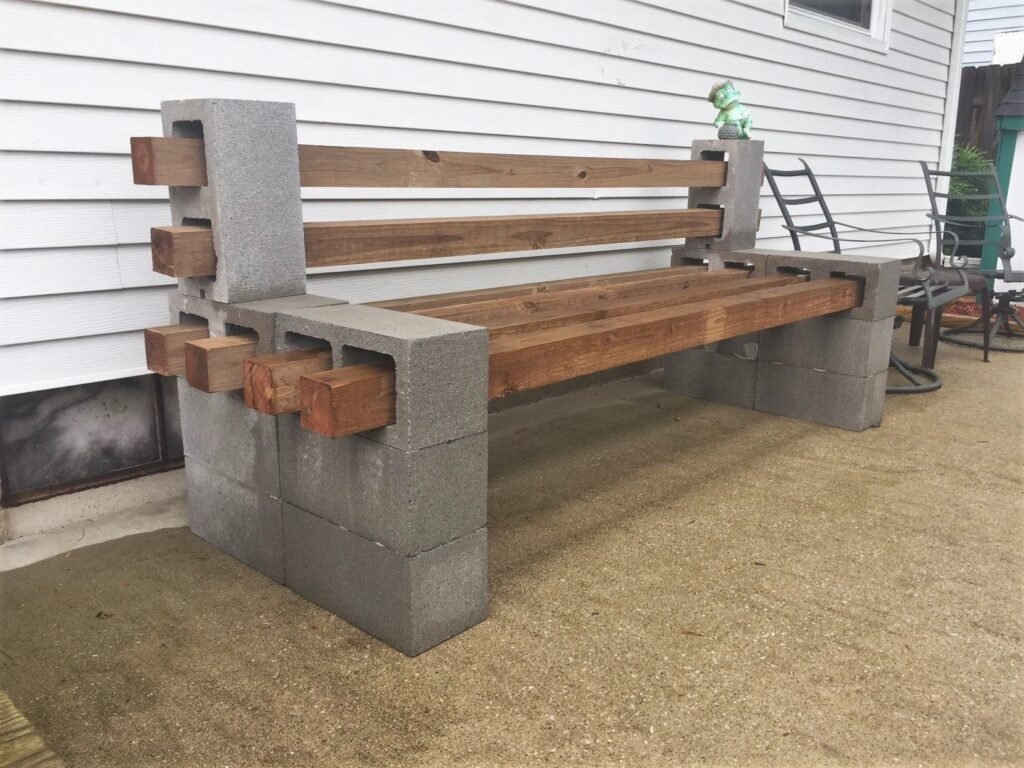In recent years, home design trends have leaned increasingly toward do-it-yourself (DIY) projects that combine aesthetics with practicality. Among these, the cinder block bench has emerged as a favorite for homeowners, urban gardeners, and outdoor enthusiasts alike. With its rustic charm, easy construction, and affordable materials, a cinder block bench offers a creative and sturdy seating solution for patios, gardens, balconies, or even indoor spaces. It is a prime example of how industrial materials can be transformed into useful, attractive pieces of furniture.
Understanding the Basics of a Cinder Block Bench
At its core, a cinder block bench is made by combining standard concrete masonry blocks with wooden planks to form a stable seating structure. The blocks act as both the legs and the frame, while the wooden beams function as the seating surface. The weight and shape of the cinder blocks provide natural support without requiring nails or complex assembly. This simplicity is what makes the design so accessible, even for people with limited DIY experience.
Beyond the basic construction, cinder block benches can be tailored to suit individual tastes. From choosing different wood finishes to painting or staining the blocks themselves, the creative possibilities are nearly endless. Cushions, throw pillows, and built-in planters can be added to enhance both comfort and aesthetics.
Why Cinder Block Benches Are So Popular
The popularity of cinder block benches stems from more than just their practicality. Their industrial look pairs well with modern, minimalist, and rustic outdoor decor. Additionally, they’re often seen as a sustainable option because they make use of basic building materials that are often readily available, sometimes even salvaged from previous construction projects. This kind of resourcefulness appeals to eco-conscious individuals and minimalists who value function and frugality over elaborate, high-cost furnishings.
Cinder block benches also offer the advantage of durability. Unlike many mass-produced outdoor furniture items made of plastic or fabric, these benches hold up well against weather conditions. The heavy nature of the materials means the bench won’t easily shift or tip, even in windy environments. This reliability makes it a smart choice for long-term use in any outdoor setting.

Creating a Comfortable Space with Cinder Block Benches
Although the core structure is solid and durable, comfort is a key factor when incorporating a cinder block bench into your outdoor or indoor space. Adding wooden planks with a smooth finish or applying a light sanding treatment will prevent splinters and improve the tactile experience. Cushions or foam padding can also be used to make the bench more comfortable for extended sitting periods.
For those looking to incorporate more warmth and personality, adding colorful cushions or fabric covers can completely transform the look of the bench. With each seasonal change, it’s easy to update the accessories and give the bench a refreshed appearance, making it a versatile and evolving piece of furniture.
Lighting and accessories such as lanterns, small tables, or garden decorations can further enhance the space around the bench. When thoughtfully integrated, the cinder block bench becomes more than just a place to sit; it becomes the centerpiece of a welcoming and well-designed outdoor retreat.
How to Integrate the Bench into Various Settings
One of the great things about a cinder block bench is its adaptability to different environments. In a garden setting, it blends naturally with foliage and can be positioned under trees or alongside flower beds. On a patio or deck, it creates defined seating areas for gatherings, reading, or dining. In more urban settings, it can be placed against a wall, paired with potted plants, and used to carve out a small relaxation space in a bustling city environment.
Some people have even used cinder block benches indoors, especially in industrial lofts or minimalist homes where concrete and wood textures are part of the interior design theme. With a few additional modifications—such as applying protective pads underneath the cinder blocks or sealing the wood—it can become a functional and artistic piece inside the home as well.
The Artistic Possibilities of the Design
Beyond its function, a cinder block bench is a canvas for artistic expression. The blocks themselves can be painted in various colors, patterns, or even stenciled with designs to reflect the personality of the space. The wood can be stained in natural tones or coated with vibrant hues that complement outdoor surroundings or personal style.
Creative builders often incorporate features such as flower planters within the holes of the cinder blocks or attach vertical structures like backrests made from reclaimed wood. This kind of customization allows each bench to be entirely unique. The process of building and decorating the bench becomes a fulfilling creative endeavor as well as a practical project.
Some even go a step further and incorporate LED lights beneath the seat or in the openings of the blocks to add a soft, ambient glow for nighttime use. These details not only add beauty but also extend the bench’s usability into evening hours, making it perfect for outdoor gatherings or quiet moments under the stars.
Maintenance and Longevity
One of the best features of a cinder block bench is its minimal maintenance. Cinder blocks are made from concrete, which is resistant to rot, pests, and general wear and tear. The wood used in the seating area, however, should be treated or sealed to protect it from moisture and sun exposure. A simple water sealant or weatherproof stain can significantly extend the life of the wood.
Occasionally cleaning the bench with a hose or damp cloth will keep it looking fresh. If paint or finish begins to fade over time, it can be easily touched up. In the rare event that a block cracks or a piece of wood becomes damaged, individual parts can be replaced without needing to rebuild the entire bench. This modular nature contributes to the bench’s long lifespan and overall value.
A Sustainable and Creative Choice
In an age when many consumers are looking for ways to live more sustainably, the cinder block bench stands out as an excellent option. It encourages reuse, supports creative freedom, and resists the throwaway culture associated with many store-bought furniture items. Whether made from new materials or repurposed from old projects, this bench promotes a DIY ethos that values craftsmanship and intention.
For those interested in exploring design, construction, or just enhancing their outdoor spaces, the cinder block bench is an ideal starting point. It offers an opportunity to engage in a meaningful project with lasting rewards—practical seating, visual appeal, and the satisfaction of building something useful with your own hands.




















